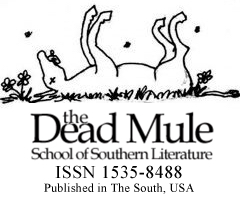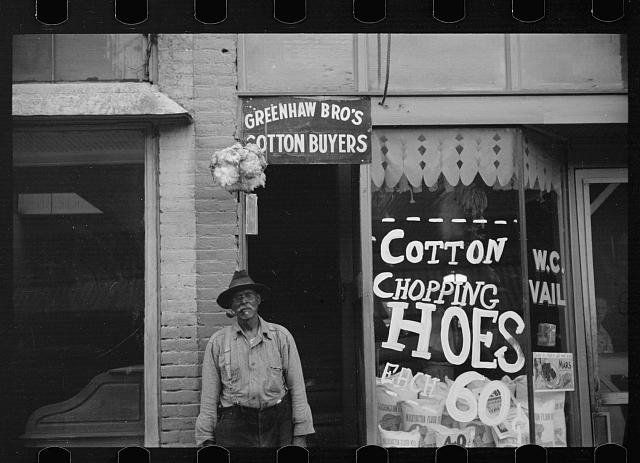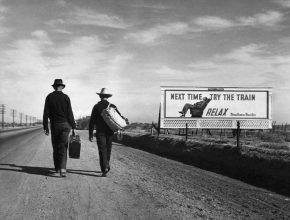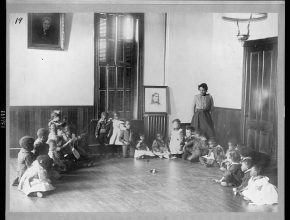Southern Legitimacy Statement: We were a prototypical southern nuclear family. My Papaw came up in the Great Smokey Mountains, near Farner, Tennessee and Cherokee, North Carolina. When he was nine, he lost track of the time one summer evening, squirrel hunting up on the mountain, and he avoided a sound late-for-dinner whoopin’ by running away with the circus. He didn’t see his own mother again for almost five years; she took him for a drifting mendicant child when he appeared in their doorway one night begging for leftovers and a place to sleep. He stayed home and worked on the family farm, and in time he got married and filled his own home with six children, all of whom were taken early by TB, among other ailments, along with his young wife.
To escape the tragedy of the loss of his family, Papaw left the Smokies altogether, and he eloped with the young English/Cherokee girl who had brushed his late wife’s hair before their wedding. He worked on the railroads as a cook, and he worked in the coal and zinc mines in East Tennessee and West Virginia and Kentucky. Their first born child was my mother, and they had five more children after that in a little government-issue stick-frame house on Alabama Avenue, in Oak Ridge, Tennessee, where Papaw fibbed his way into a life-long career as a machinist at Y-12 and K-25. Papaw died of intestinal cancer in the late 1970s, though had he survived it, he would have died eventually from complications related to moonshine and general orneriness.
Since Mamaw’s Cherokee showed in her cheeks and in her hair in ways that were impossible to disguise, the only job made available to her in the Secret City was one washing radiation suits; her government-issued safety gear was a pair of Rubbermaid gloves. She died of a brain tumor almost forty years ago. Beneath her name, Julia Bryant, our family tree reads like a medical encyclopedia from an apocalyptic future, but we tend to wear it proudly as a clan. To quote Peter Benchley’s Cpt. Quint, “Anyway . . we delivered the bomb.”
A Requiem for Grandmother Tree
In the spring of 2005, a great colony of Purple Martins roosted in the Bradford pear trees that lined the parking lot next to the farmers market on 17th Street in Richmond; local print and film media both date their arrival much later, but I saw them arrive with my own eyes in the spring of ‘05: a river of birds just appeared in the sky all at once above our apartment on Church Hill one afternoon, flying south toward the James. I had been smoking a cigarette in the sun nook . . .
“Honey! Come out here, quick! You gotta see this!”
“Wow,” she said; she is a biologist, and she doesn’t wow easily.
“Whaddaya think they are?”
She shrugged. “No bigger than sparrows. Whatever they are, we know they migrate.”
I took them as a sort of welcome back sign, and as a good luck omen. We didn’t see those birds again until the next spring, after we moved down to Shockoe Bottom into a second-floor apartment above Jaquomo’s at the corner of 18th and Franklin Street. Every evening all that spring and summer, and every summer every year until we moved to Maymont in ‘09, we watched those birds perform their great collective dragon dance above the river bottom. We called it “watching the birds.” You could set your watch by them, and they were as natural to the mathematics of Nonesuch as Monsoon rains are to the mathematics of Cathay.
“Best show in town, and it’s absolutely fuggin’ free,” said Hippy John one balmy late-summer afternoon.
That was the last time I ever spoke with Hippy John before we moved. He had a private theory, one he shared with me that day over a pint of Richard’s Wild Irish Rose, that the birds were the spirits of slaves who died at the old Lumpkin Jail site – the ones who were buried there and a few who were not – where there is and was then only a small unremarkable plaque to mark the nightmare of their final days.
“The last great act of defiance,” he said. He grinned his big beautiful grey-bearded grin. “A ritual dance of magnificent transcendence. They are the Birds of Freedom, and they fly all the way up here from the beach in Costa Rica every summer, just to tell old Lumpkin to fuck off again in the most spectacular way imaginable.”
I have no idea why the Martins made the decision to relocate to Maymont Park that year after their four years in The Bottom. Dancin’ Pops was convinced that the sudden notoriety had driven them away; added attention was one thing, he said, but a whole Purple Martin Festival was quite another matter.
“Besides,” Pops said, “You know the mayor wasn’t givin’ em no cut on the merch or nothin.’”
We moved in ‘09 because the village had gotten violent. It had always been violent, even in Poe’s day, in the way that all cities are violent or carry the constant potential for violence that comes from vice and the businesses that market it. The violence was different now, though: something had changed after the Harvey family was murdered on New Year’s Day in ‘06, across the river in Manchester. When I look back now, I see that event as a sort of spiritual marker on our collective timeline. That story took the wind out of the whole city; and no one who heard it had been able to keep their antennae intact.
Since then, the violence downtown had assumed more of a mob identity, and innocent bystanders were getting hurt on an alarmingly frequent basis, including the homeless. The violence was no longer simply conditional to adults having fun; rather, there was a pervasive dark spirit that had soaked into the very fibers of the heart of the city. Two years after the Harvey murders, when we got the news from Dancin’ Pops that Buster and his brother had both gotten their throats cut by the crack-dealer boyfriend of the niece they had allowed to move into their new section-eight apartment in Manchester, neither of us even had to say a word. It was time to leave.
Almost two years later, in the Spring of 2010, I discovered by accident one day that the colony of Purple Martins who had lived with us in Shockoe Bottom had taken roost in the branches of a giant Tulip Poplar at Maymont Park that I had known since I was a little boy, and that in my adulthood I had come to call Grandmother Tree for the uniquely quieting grandmother spirit I always felt hushing me down whenever I sat in her presence.
If there is enough of the child left in you to associate the memories of beloved places with specific trees, and to remember those trees with the depth of fondness with which you remember a long-lost friend, then you already understand all you need to know about Grandmother Tree, except perhaps that she was well over two centuries old, and the oldest thing alive anywhere on the north bank of the James River Falls – a fact documented thoughtfully on a placard displayed at the convergence of footpaths beneath the hillock where she alone had stood down the centuries, holding the earth and sky together.
She was one of those rare trees that feel more like supernatural architecture than flora; her canopy was a forest’s worth of branches outstretched, balancing the whole of the sky while weaving themselves inextricably into it, and when early summer winds blew, she spoke in a hundred disparate calming voices, each recognizable as the voice of close kin, and all of them loving. It was in the process of listening to those voices one warm day in the early summer that I discovered the birds again. It was twilight, just shy of dusk, and they were making their dive-bomb descent to settle in little clusters high up in the canopy for the night, their watery, warbling melody growing by increments and then cascading down all at once like a waterfall of birdsong. I was meditating, and the sound of them had encroached, assembling me back from the edges of the astral . . .
There are doubtless those who will insist that it was some different colony, or a splinter colony from the original colony of Martins, but I know better. I knew their spirit, after all, knew it better than probably anyone else in Richmond, with the possible exception of my old friends James and Diane, who spent their summers sleeping in the vestibule of an abandoned shop down the block from Weimann’s bakery back in the day, right next to that stand of Bradford Pears where the Martins used to roost, and with whom I used to sit sometimes until early in the morning summer nights, just sipping wine, smoking reefer, listening to the birds.
Whether they are the same Martins, they summer somewhere else now. I have not seen them since 2018. I thought I heard some of them one afternoon last winter in a stand of old Willow Oaks in the middle of the neighborhood, but I couldn’t get a fix on them long enough to be sure. In the end, it was probably just wishful thinking. After all, it was the middle of winter. They won’t be coming home to Grandmother Tree again, anyway, because we lost her last fall in one of the big storms that blew through during hurricane season. I found her one morning at the end of a long walk, and the jolt of it stopped me cold in my tracks: seeing her there, broken like that, but only half torn down, the rest of her piteously still standing, awkwardly awaiting the saws of a demolition crew, it all came rushing back, all of the past two years of watching my city get hurt in so many ways that I knew in my heart no one would ever be able to fix. Not really.
A river makes a city; Pliny said that, though I heard my father say it first and prefer to remember it as his quotation. Next to the river is the architecture and, inside that, the people; and there is something both essential and unique added to a city by the community that lives within it over time, a fragile spirit that one can only describe as the singular personality of that city, as its character. All great cities have a character, and even some mediocre ones, and that is something very much organic and irreplaceable.
Once you damage that spirit, it can take lifetimes to repair, if indeed it can be repaired at all, because the spirit of a community of a city is not something planned, nor something one simply manifests with proactive rational social justice campaigns driven by well-meaning academics and social planners, but rather something born of a million instances of accidental neighborly love and anonymous compassion over years and years of time. It takes decades to build, though apparently it can be killed outright, or at least critically wounded, in no more time than it takes to open and close the public pool for a season.
I still try to visit Grandmother Tree at least once a week; I sit in the middle of her stump looking down over the little valley toward the pen where they keep the bison when I meditate sometimes; and when I am there surfing high on the right frequency of nothingness, I can feel her there blissfully lifting me up, up, up, high into her branches, and holding me there in memory, helping me see the world from her point of view. I can feel her there all around me, as real and as magnificent as she ever was, and together in perfect silence we sit, and we await the possible return of our friends the Purple Martins.
(end)







